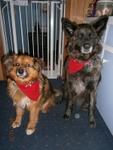Leptospirosis...We found out that that's what Micki has



There are 7 strains of it, he tested positive for four. The worst part is it's contagious...to humans and other animals. O..M...G. I was sick last weekend (chills, high fever, headache) exactly the symptoms of this disease, I'm fine now but it's known to go dormat. We're getting antibiotics for all of us, and getting the dogs vaccinated for 2 of the strains Micki has (there isn't a vaccination for the other two) and all we can do is watch for symptoms in the other guys and rush them immediately in if they change.

I'm going to be gone all weekend, so I won't get a chance to update until Monday. But here's a little info on the disease if you're curious.
--------------------
Leptospirosis is a bacterial disease that affects many species of animals as well as human beings. Leptospirosis occurs throughout the World. The organism belongs to a phylum called spirochaetes, distinctive bacteria with long, helically coiled bodies. They can be recognized by the presence of flagella or ribbons running lengthwise down the cell and called axial filaments. These filament causes a twisting, spiral motion as the organism moves about. Most spirochaetes are free-living without oxygen (anaerobic) with only the Leptospira, the Borrelia of Lyme disease and the Treponema of human syphilis causing disease.
There are approximately 230 serologically distinct forms of the genus and species, Leptospira interrogans, which are called serovars. Nine serovars are known to cause disease in dogs. They are Leptospira icterohaemorrhagiae, L. canicola, L. grippotyphosa, L. pomona, L. bratislava, L. automnalis, L. bataviae, L. hardjo, and L. grippotyphosa . The first four serovars are most commonly isolated from dogs. In North America, the disease is perpetuated in domestic cows, horses and pigs and in wildlife that include mice, rats, raccoons, opossums, fox, skunk, deer, and woodchucks.
Transmission
Dogs become infected with leptospira through contact with the urine of infected animals. Stagnant water, contaminated with urine is a common source of infection as are rats. The organism can also be transmitted through mating, bites, and the consumption of infected carcasses. There are documented cases where transmission from parent to offspring occurred through the womb. Transmission is greatest during periods of wet weather.
Dynamics Of The Disease
Leptospira gain entrance to the bloodstream through mucous membranes or wounds. It takes 4-12 days for symptoms to occur. Once in the blood stream the organisms spread rapidly to body organs that include the liver, spleen and kidneys. The nervous system, genital tract and eyes also harbor leptospira. As the dog fights the disease by producing antibody, the organisms are cleared from most of the organs, remaining only in the kidneys from which they are shed for weeks or months in the urine. When death occurs it is often due to destruction of the liver (hepatitis). Liver necrosis is most common in dogs less than six months old. L. pomona and L. icterohaemorrhagiae have a predilection for the liver while L. canicola and L. grippotyphosa often spare the liver but colonize the kidneys. When people become infected , one third obtain the infection through contact with carrier dogs while another third contract the disease from contact with rats.
Symptoms of Leptospirosis
The first signs of leptospirosis are fever and depression. Dogs developing this disease are cold and shiver. They appear to ache and be tender all over. Soon they develop fevers of 103-104 degrees Fahrenheit. Joint pain and excessive bleeding sometimes occur. The dogs stop eating and drinking and often drool and vomit. Through vomission they loose fluids and become dehydrated. Dogs with fulminating infections soon become subnormal in temperature (hypothermia) and may die before signs of kidney and liver failure develop. In other dogs, infection of the kidneys leads to blood tinged reddish urine, oral ulcers and uremia. Inflammation of the covering of the brain (meningitis), inflammation of the iris and ciliary body of the eye (uveitis) and abortion have all been reported.
Dogs with more moderate cases of the disease soon drink water excessively. Their tenderness and reluctance to move is due to painful swollen kidneys. In those with liver involvement, the membranes that line the mouth and surround the eyes become yellowish (icteric, jaundiced). The majority of these dogs go on to recover in two or three weeks but a few permanently loose kidney function and die slowly from waste product overload (uremia). The dogs that recover can shed leptospira in their urine for months or even years. In these dogs the organism continues to live in the kidneys and reproductive organs.
Blood samples taken from dogs well into the disease process often show an elevated white blood cell count and a deficiency in thrombocytes which causes bleeding. Blood serum chemistry values often show kidney damage (elevated BUN and creatinine) and liver damage (elevated AST, ALT, Alkaline Phosphatase and bilirubin). Urine obtained from infected dogs may contain blood, protein and sugar reflecting damage to the kidney’s tubular filtering apparatus.
Diagnosis
Leptospirosis is diagnosed through test of the blood serum that measure the level of antibody present as well as the identity the strain of leptospira present. Fluorescent antibody tests or polymerase chain reaction tests identify the serovar responsible for causing the dog’s disease. The microscopic agglutination test or MAT is the most common test for antibody. It takes at least ten days for the dog to begin to produce antibody against the disease and several tests may be necessary to confirm the diagnosis. While a serum titer of 1:800 or more makes the disease highly likely a second test should be performed showing a rising titer in order to confirm that the infection is active. Recent leptospirosis vaccination can cloud the diagnosis. Occasionally, the bacteria can be isolated from the urine of infected dogs. A procedure called darkfield microscopy can identify leptospira in the urine sample. When the disease spreads to the dog’s owner the initial signs are fever, headaches, rash, myalgia and malaise.
Treatment
The first line of treatment of leptospirosis is to provide the dog with a suitable antibiotic. The penicillin class of antibiotics works well against leptospirosis (Penicillin G procaine 10,000-20,000 units/lb injected intramuscularly twice a day). After the acute phase of leptospirosis has passed, the drug of choice to prevent carrier states is doxycycline (1.5-2.5mg/lb twice a day orally). The newer fluoroquinolone antibiotics such as enrofloxacin and ciprofloxacin (2.5-10mg/lb/day) are also effective in treatment and elimination of carrier states. In addition to antibiotic therapy, medications are administered to stem vomiting and intravenous and subcutaneous fluids are give to correct dehydration. Dogs that die of the disease often do due to kidney failure. To prevent this, copious intravenous fluids help flush out the kidneys and prevent their destruction. When this is not sufficient and toxic waste products continue to build up in the dog’s body, hemodialysis has been effective in saving their lives.
Vaccination And Prevention
Limiting exposure to leptospira necessitates draining or fencing off sources of contaminated water. Vermin need to be eliminated from residential and rural areas. The best way to do this is to seal and protect all sources of feed that rodents and other vermin utilize.
The vaccines available for dogs are all killed extracts of leptospira. Most contain four of the nine serovars, L. canicola, L. icterohaemorrhagiae, L. grippotyphosa and L. pomona.
These bacterial extracts are usually marketed combined with living, attenuated (weakened) virus of canine distemper and parvovirus. When a vaccine reaction occurs in a dog, it is usually the leptospira extract or the antibiotic preservative that is the cause.
The leptospira portion of these vaccines produces six to eight months of immunity in dogs. Therefore, dogs kept in high exposure areas should be vaccinated twice yearly.
I begin by vaccinating puppies at 9, 12 and 16 weeks of age. Leptospirosis vaccination is optional in house pets that are unlikely to be exposed to the disease.
Kansas State University College of Veterinary Medicine no longer recommends that household urban dogs be vaccinated for leptospirosis. They give several reasons for this new recommendation:
1) The disease has become quite rare in the urban dog.
2) A more important reason is the frequency with which we see hives, facial swelling and even life-threatening vaccination reactions called anaphylaxis when we give vaccine “cocktails” that contain leptospirosis bacteria. The ”L” in DHLP, the most common vaccine cocktail, stands for leptospirosis. These reactions can be very mild or severe enough to cause death. These reactions do not occur on the initial vaccination but do increasingly on succeeding vaccinations.
3) The third reason is that the vaccines against leptospirosis are not that effective in preventing the disease and may actually facilitate carrier states.
Bad News...)))


There are 7 strains of it, he tested positive for four. The worst part is it's contagious...to humans and other animals. O..M...G. I was sick last weekend (chills, high fever, headache) exactly the symptoms of this disease, I'm fine now but it's known to go dormat. We're getting antibiotics for all of us, and getting the dogs vaccinated for 2 of the strains Micki has (there isn't a vaccination for the other two) and all we can do is watch for symptoms in the other guys and rush them immediately in if they change.








 Reply With Quote
Reply With Quote


















Bookmarks